|
Prepare to assemble the kit by checking the parts list and verifying you have everything!
Next, heat up your soldering iron and clear off your desk.
Place the circuit board in a vise so that you can easily work on it |
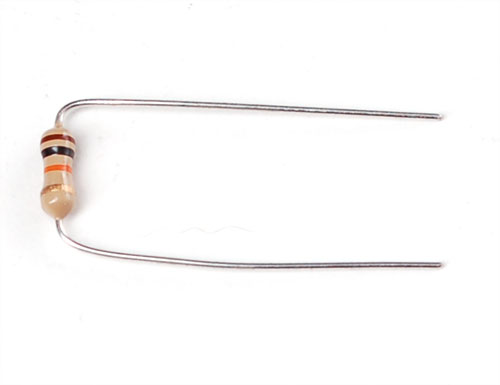 |
The first part we're going to solder is a 10K
resistor. The 10K resistor is striped Brown Black Orange Gold. Bend the
resistor into a staple as shown. |

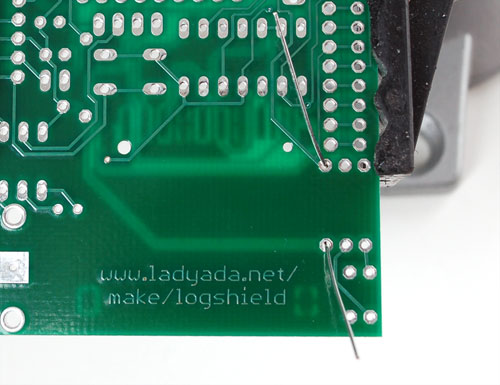
|
Place the resistor in the location marked R5. Resistors do not have polarity
which means you can put it in 'either way' and it will work just fine.
Bend the wire legs out so that the resistor sits flat against the PCB.
This resistor is necessary to keep the SD card deactivated
when not in use - this prevents accidental writes to the card that could
scamble it! |


|
Turn the PCB over. Using your soldering iron
tip, press and heat both the pad (the silver ring around the hole) and
lead (wire) at the same time for 2 or 3 seconds. Then poke the end of
the wire into create a nice solder joint. Do this for both leads. |

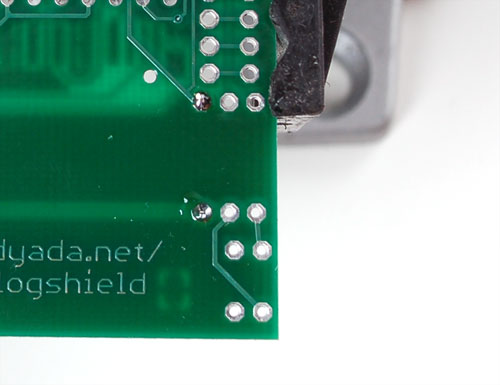
|
Using your diagonal cutters, cut off the long leads just above the solder joint. |
 |
The next two resistors are 1.0K - their color strips are Brown Black Red Gold.
Bend and place them in the slots labeled R3 and R4
These resistors set the brightness of the two indicator red/green LEDs |



|
Flip over the PCB and solder the 2 resistors. |
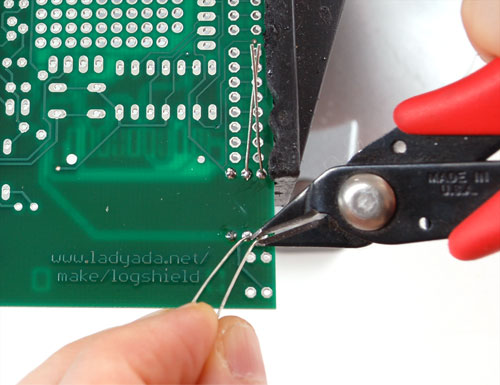
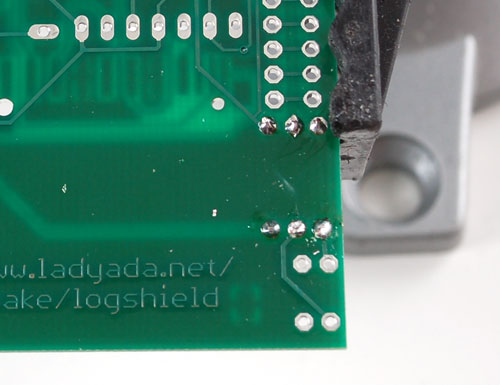
|
Clip the two resistors' leads |
 |
Once you are feeling comfortable with the
resistors, lets do the SD card holder. The holder is surface mount
(there are no wires that go through the board) but the spacing is very
generous, so it wont be difficult.
The holder has two bumps that 'snap' into place on the PCB. Make sure that the bumps are engaged and the holder is sitting flat. |

|
The first step to soldering the holder is to
'tack' it in place. On the sides are 4 large tabs. Heat both the pad and
tab together for 3 seconds and solder the tab down. Repeat for all 4
tabs. When you're done you shouldn't be able to move the holder. |
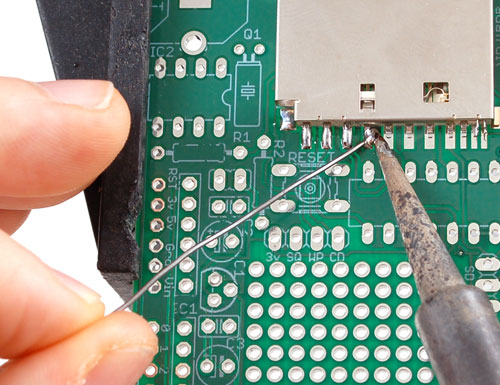

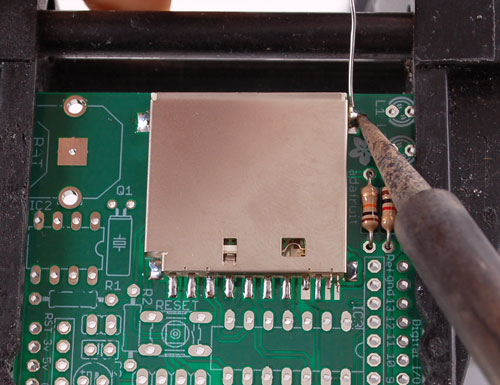
|
Next, solder the 8 large leftmost pins of the
holder to the corresponding pads. (in the photos, the 8the one doesnt
look completely soldered but it is) Use a sparing amount of solder so
that you wont end up bridging two pins by accident. If you aren't
skilled at SMT soldering, you can simply skip the last three smaller
pins, they're not at all necessary |
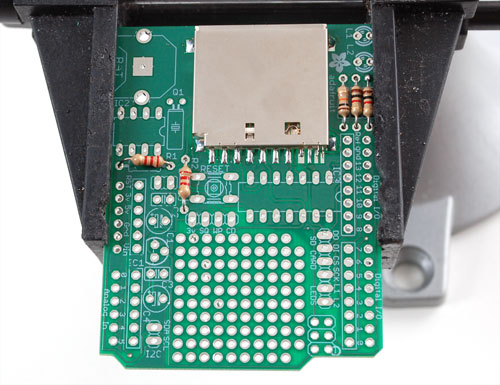
|
We will now solder in the two 2.2K resistors (Red Red Red Gold) into the two slots labeled R1 and R2
These two resistors are used by the RTC chip data lines. |



|
Solder the resistors using your now-expert resistor soldering skills |

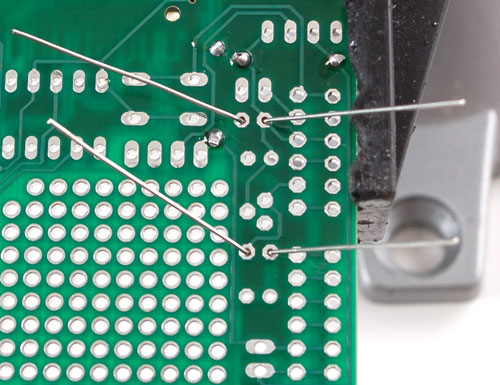
|
Next we will install the two yellow ceramic capacitors C2 and C3. Ceramic capacitors are not polar so they can be inserted either way and will work fine.
Bend out the leads like the resistors to keep them flat against the PCB |

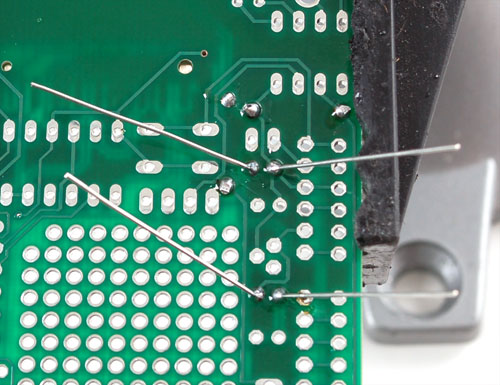

|
Place, solder and clip the capacitors. |

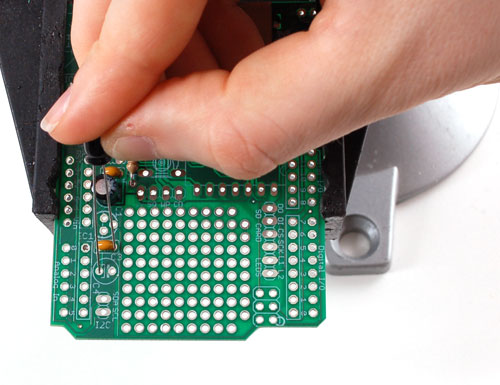
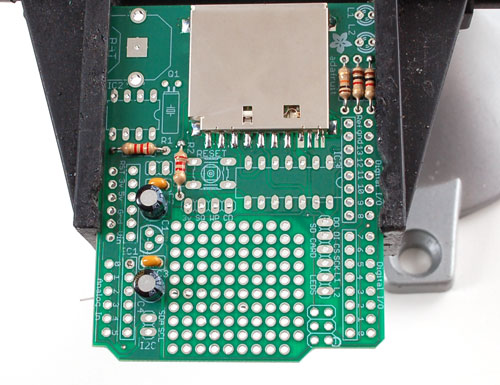
|
Next are the electrolytic capacitors C1 and C4.
Electrolytic capacitors are polarized and must be placed
correctly. The longer lead of the capacitor is the positive (+) lead.
Make sure this lead is placed in the hole marked with a +.
Look carefully before soldering to make sure you got this part right!
|

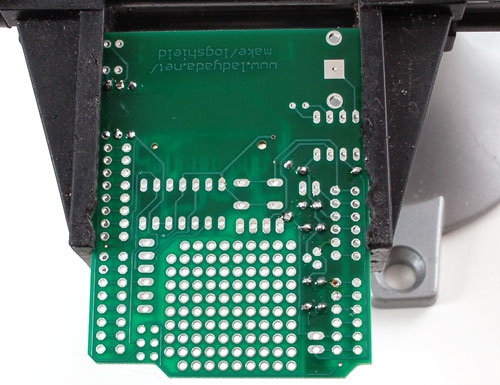
|
Solder and clip |


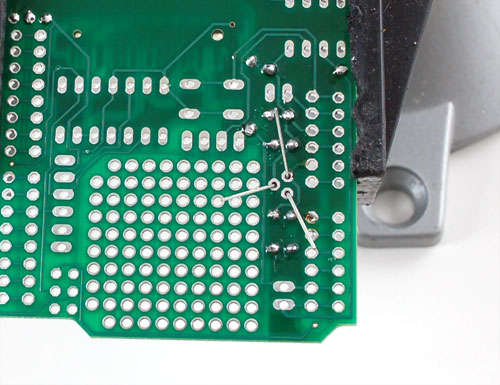
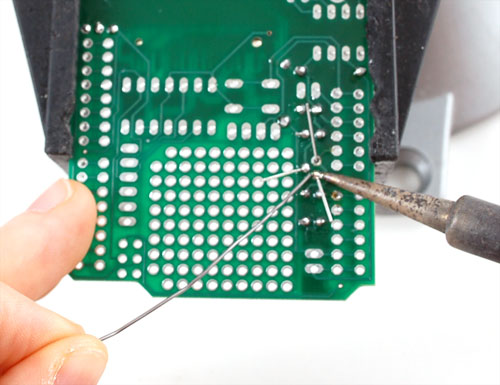
|
Next we will solder in the 3.3v regulator.
The regulator is in a TO-92 package, with a semi-cylindrical plastic
part and three legs.
Insert it into the location marked IC1.
Because of the way the pads are layed out, the regulator wont sit flat
against the PCB. Thats OK, it should stick up a little bit. Make sure
the flat side of the package matches the outline on the silkscreen
Solder and clip the three leads |



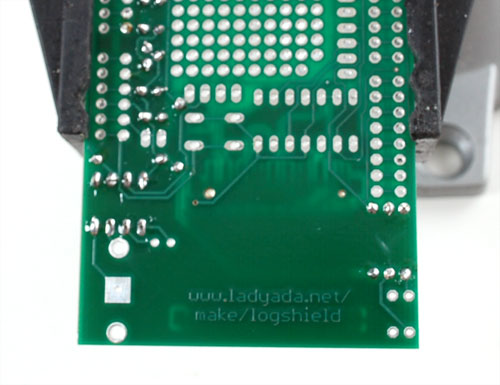
|
Next we will place and solder the 8 pin socket.
The socket is for protecting the clock chip and making it
easy to insert and remove. Unfortunately, RTCs often shouldnt be removed
which means that placing this part is not always preferrable. If the
loggershield is going to be used in a place where the chip may get
knocked out, you may want to skip the socket and just solder the chip in
The socket has a little notch in one end. That notch should
match the one in the picture silkscreened onto the circuit board. This
will help you place the chipin properly later. In this photo its on the
LEFT
You may need to solder one pin of the socket while holding it
it in with a finger (or tape) as the legs aren't long enough to be bent
while in place. |
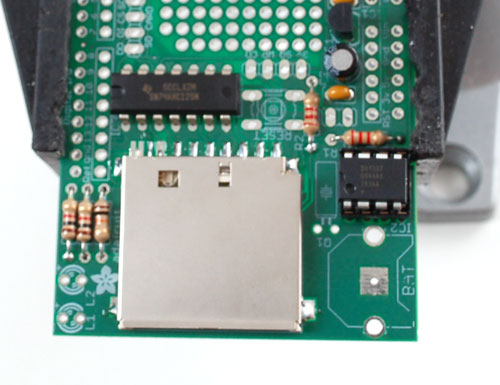
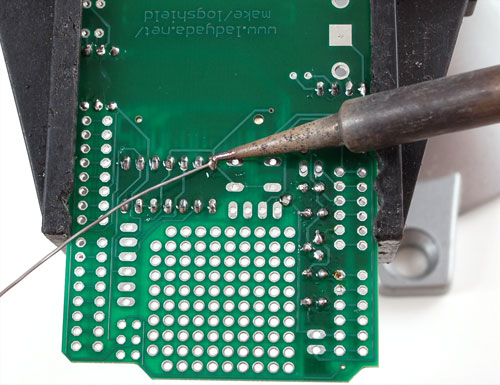

|
Now you can place IC2 the
DS1307 RTC chip into the socket by gently bending the pins in so that
they line up with the socket and the dot and notch in the chip are on
the same side as the socket notch. The RTC is what keeps time when the
power is out, its a very very very low power microcontroller and crystal
that will keep time for years on a tiny coin cell. This way you can mod
your clock with ease and not have to reset it after power loss.
The next chip IC3 is the 74AHC125 which is the 3.3V buffer chip that converts the 5V signals from the Arduino to the 3.3V SD-card
IC's must be placed a certain way, or they dont work. Make
sure you get this right because if the part is in wrong its a real pain
to fix!
On one end of the chip is a round notch. Make sure this
notch matches the silkscreen underneath where there a similar round
notch. In thie photo its on the LEFT
Solder in all the pins of the chip |


|
First, melt a tiny bit of solder onto the center tab of the battery holder BAT. This will make good contact with the battery.
|


|
Now place the 12mm coin battery holder BAT and the 6mm button RESET.
The button is a symmetric part so it can go in two ways. Line up the
metal legs with the holes in the circuit board and snap it in. The
button should sit flat against the circuit board.
Tack solder one side of the battery holder so it doesnt fall out when you flip over. |

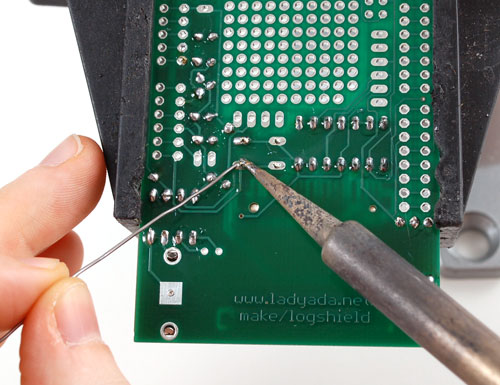
|
Now solder the button and battery holder into place. There's nothing to clip. |
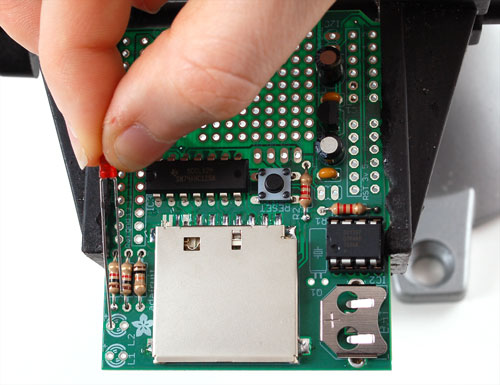

|
Next are the red and green indicator LEDs. LED
stands for Light Emitting Diode, and they must be placed correctly or
they wont work. To make sure the LEDs are installed properly, check that
there is a lead that is longer than the other. This lead is the
positive (+) lead. Make sure that this lead goes into the hole marked
with a + on the PCB silkscreen, as shown. |
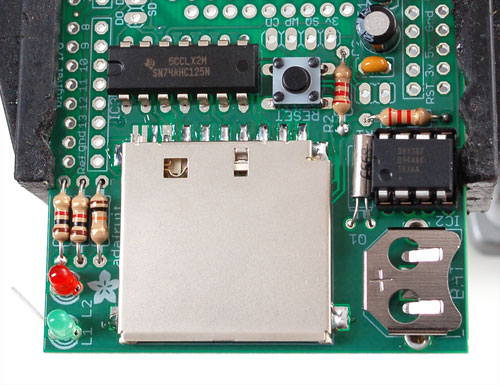 |
Next is the 32.768 KHz watch crystal Q1.
The crystal is the same as whats in your 'quartz' watch or clocks - it
is the thing that ticks to tell time. The crystal is nonpolar. |

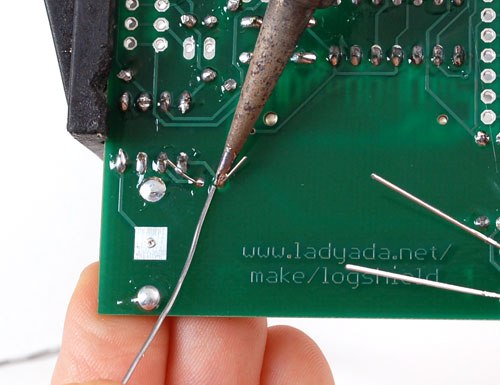

|
Solder and clip the two LEDs and crystal |

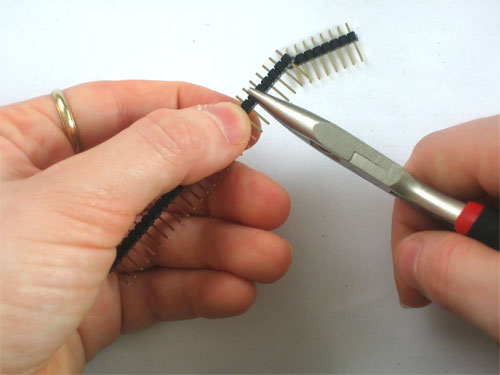

|
Next, break the 36-pin header strip into
smaller sections so that the shield can be placed on the Arduino. You
can use pliers or diagonal cutters.
You will be able to perfectly snap the long strip into 2 8-pin strips, and 2 6-pin strips. |
|
Put the long ends of the male header in to the female header on the Arduino, as shown |
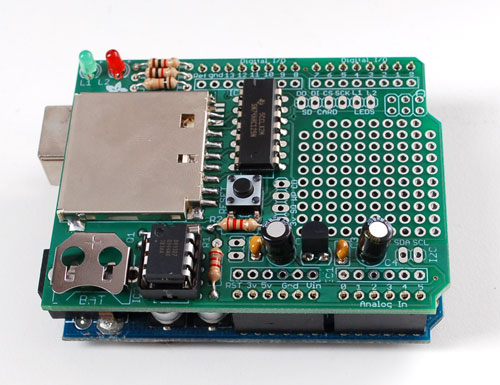

|
Put the shield on top of the Arduino, so that the male header aligns with the solder holes.
Solder every pin of the male header. Keep the shield on the Arduino to make the job easy.
Once you're done, you can remove the shield from the Arduino. |
 |
The last assembly step is to insert the
battery. The flat side goes up. It will last years so you will only have
to do this once. |
 |
You're done! Now you can get an SD card and start reading the usage documentation! |